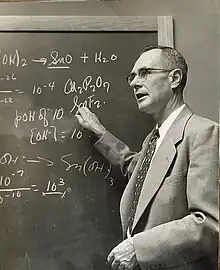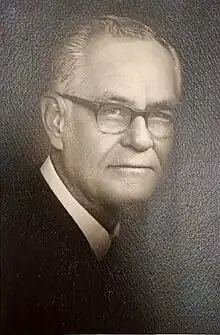

William Harrison Nebergall (21 December 1914 – 2 September 1978) was an inorganic chemist who synthesized the fluoride compatible polishing agent calcium pyrophosphate.[1] This discovery combined with stannous fluoride led to the development and release of the first fluoride containing toothpaste, Crest, in 1955.[2] In 1960 Crest became the first toothpaste to be endorsed by the American Dental Association as an effective decay-preventing agent.[3][4] In 1959 he cowrote one of the first widely used textbooks of college chemistry titled General Chemistry, which was published in six editions.[5]
Early life
William H. Nebergall was the second of four children of Clarence Cleveland Neberball and Zelpha Maude Miller Nebergall. He was born in a farm house in Cuba, Illinois and attended a one-room school house in Cuba. Nebergall felt like phonetis and extensive drilling in spelling and arithmetic were more important in education than extensive curricula and palatial physical facilities.[6] He married Florence Johnson on 18 September 1940 and had three children: William, James, and Susan.
Nebergal received his Bachelor of Education Degree at Western Illinois State Teachers College in 1936 and his Masters of Science in chemistry from University of Illinois in 1939. He spent the next 10 years as a college chemistry instructor, including East Tennessee State Teachers College in Johnson City from 1939 to 1941, at the University of Kentucky from 1941 to 1942, at State Teachers College in Superior, Wisconsin from 1942 to 1944 and then starting in 1944 at the University of Minnesota where he received his Ph.D. in chemistry in 1949.[7]
Indiana University
In 1950, Nebergall was offered and took a position at Indiana University Department of Chemistry as an assistant professor.[8] It was here that he was introduced to Joseph C. Muhler, DDS, who was working on Ph.D. in chemistry.[9]
While Muhler was in dental school at IU he had begun research in the use of fluoride to reduce dental carries. It had been widely known that natural occurring fluoride in ground water could reduce or elimite dental caries based on studies performed early in the 1900s by the dentist Frederick McKay.[10] Muhler began using samples of various fluoride salts that were produced by fellow IU chemists Frank C. Mathers[11] and determined that stannous fluoride produced the most robust dental decay prevention.[12]
During the course of the stannous fluoride research it was found that the dicalcium phosphate polishing agent in the dental paste readily absorbed fluoride making it unavailable for use in fighting cavities. Nebergall knew that heating the dicalcium phosphate to between 300 and 1100 degrees Celsius resulted in the structure being converted to calcium phyrophoshate which would not react with the stannous fluoride while keeping the polishing properties of dicalcium phosphate. This finding led to Nebergall's US patent number 2,876,166.[13]
Muhler and Nebergall, along with Chemistry Department Chairman Harry G. Day began to publish their data to support the idea that stannous fluoride combined with calcium pyrophosphate could be used as a dental paste to help with the reduction of dental caries.[14][15][16][17][18][19][20][21][22] These studies which were financed by Procter & Gamble of Cincinnati, Ohio led to the development of Crest toothpaste whose initial marketing tag line was "Look, Ma,[23] no cavities".
References
- ↑ uspto.gov patent number 2,876,166
- ↑ Innovative products www.us.pg.com
- ↑ "Alumnus William Neberball Inducted into Inventors Hall Fame" www.cse.umn.edu
- ↑ Innovative products www.pg.com
- ↑ "General Chemistry"NEBERGALL SCHMIDT HOLTZCLAW, DC Heath and Company ISBN 0-669-02218-7
- ↑ "My Memoirs" by William Harrison Nebergall Unpublished
- ↑ "My Memoirs"
- ↑ "My Memoirs"
- ↑ "The Development of Chemistry at Indiana University 1829-1991 Harry G. Day pg 463-71 alumni.chem.indiana.edu
- ↑ nidcr.nih.gov/health-info/fluoride/the-story-of-fluoridation
- ↑ "The Development of Chemistry at IU (above)"
- ↑ MUHLER JC, NEBERGALL WH, DAY HG. Studies on stannous fluoride and other fluorides in relation to the solubility of enamel in acid and prevention of experimental dental caries. J Dent Res. 1954 Feb:33(1):33-49. PMID 13130760
- ↑ uspto.gov
- ↑ MUHLER JC, NEBERGALL WH, DAY HG. Studies on stannous fluoride and other fluorides in relation to the solubility of enamel in acid and prevention of experimental dental caries. J Dent Res. 1954 Feb:33(1):33-49. PMID 13130760
- ↑ MUHLER JC, NEBERGALL WH, Relationship between pH, age, and concentration of solutions of stannous fluoride and sodium fluoride in decreasing enamel solubility and affecting the uptake of fluorine. J Dent Res. 1952 Dec;31(6):756-60 PMID 13022829
- ↑ GRUTSH JF, NEBERGALL WH, MUHLER JC, FISHCHER RB, DAY HG. A procedure for the routine determination of fluorine in potable waters containing iron, manganese, aluminum and chlorine. J Dent Res. 1953 Aug;32(4):463-8. PMID 13084802
- ↑ MUHLER JC, RADIKE AW, NEBERGALL WH, DAY HG. Effect of stannous fluoride-containing detrifice on caries reduction in children.J Am Dent Assoc. 1954 Oct;33(5):606-12 PMID 13201693
- ↑ MUHLER JC, RADIKE AW NEBERGALL WH, DAY HG. Effect of Stannous fluoride-containing dentrifice on caries reduction in children II. Caries experience after on year. J Am Dent Assoc. 1955 Feb;50(2):163-6 PMID 13221383
- ↑ HATTON WE, NEBERGAL WH, MUHLER JC. The removal of fluorine from dilute solutions of sodium fluoride and stannous fluoride by powdered dental enamel. J Dent Res 1955 June:34(3):350-7 PMID 14381570
- ↑ MUHLER JC, RADIKE AW, NEBERGALL WH, DAY HG. The effect of stannous fluoride-containing dentrifce on dental caries in adults J Dent Res. 1956 Feb;35(1):49-53 PMID 13286385
- ↑ DAY HG, MUHLER JC, NEBERGALL WH, WALSH RH. Effects of buffered solutions of sodium fluoride and stannous fluoride on the solubility of powdered enamel using repeated decalcification. J Dent Res. 1957 Feb;36(1):118-23 PMID 13398513
- ↑ NEBERGALL WH, MUHLER JC, DAY HG. The preparation and properties of stannous fluoride. J Am Chem Soc. 1952 Mar; 74(6) 1604
- ↑ Innovative products us.pg.com